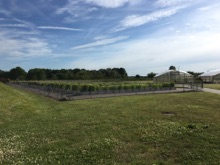The past two weeks have been a whirlwind of science travel in Europe. First, I visited our collaborator Tom Gilbert and his group in the Centre of GeoGenetics at the Natural History Museum of Denmark and University of Copenhagen. Nathan was visiting too so he could do some additional DNA extractions of the archaeological remains we have been working on as part of our sunflower domestication work. These samples went direct from our collaborators Kris Gremillion and Bruce Smith to Denmark, and so this was the first time that I have seen these disk fragments and seeds in person. The size of seeds in a packet that we’ve radiocarbon dated to 1800 years ago (top right) really drove home the point that domestication was very well underway by then. It was a great to talk science with Tom and everyone there. Plus, I got to see a Ph.D. defense talk on giant squid and lionfish and see Nathan suited up in the clean lab ready to extract (middle right)!
From Copenhagen, it was next to Hennef, Germany where I attended and spoke at the Cluster for Excellence in Plant Sciences (CEPLAS) International Summer School. Lots of interesting research presentations from faculty and students, and many great conversations over meals as well. At the end of the meeting, George Coupland also hosted me for a seminar visit to the Max Planck Institute for Plant Breeding Research in nearby Köln (field site, bottom). It was a huge honor and pleasure for me, and I had wonderful discussions with so many folks whose work I have been following and often teaching for years but had never met in person. Finally, I got to stop by University of Köln to catch up with Juliette de Meaux and also visit the enormous and amazing cathedral there as well (bottom right).




